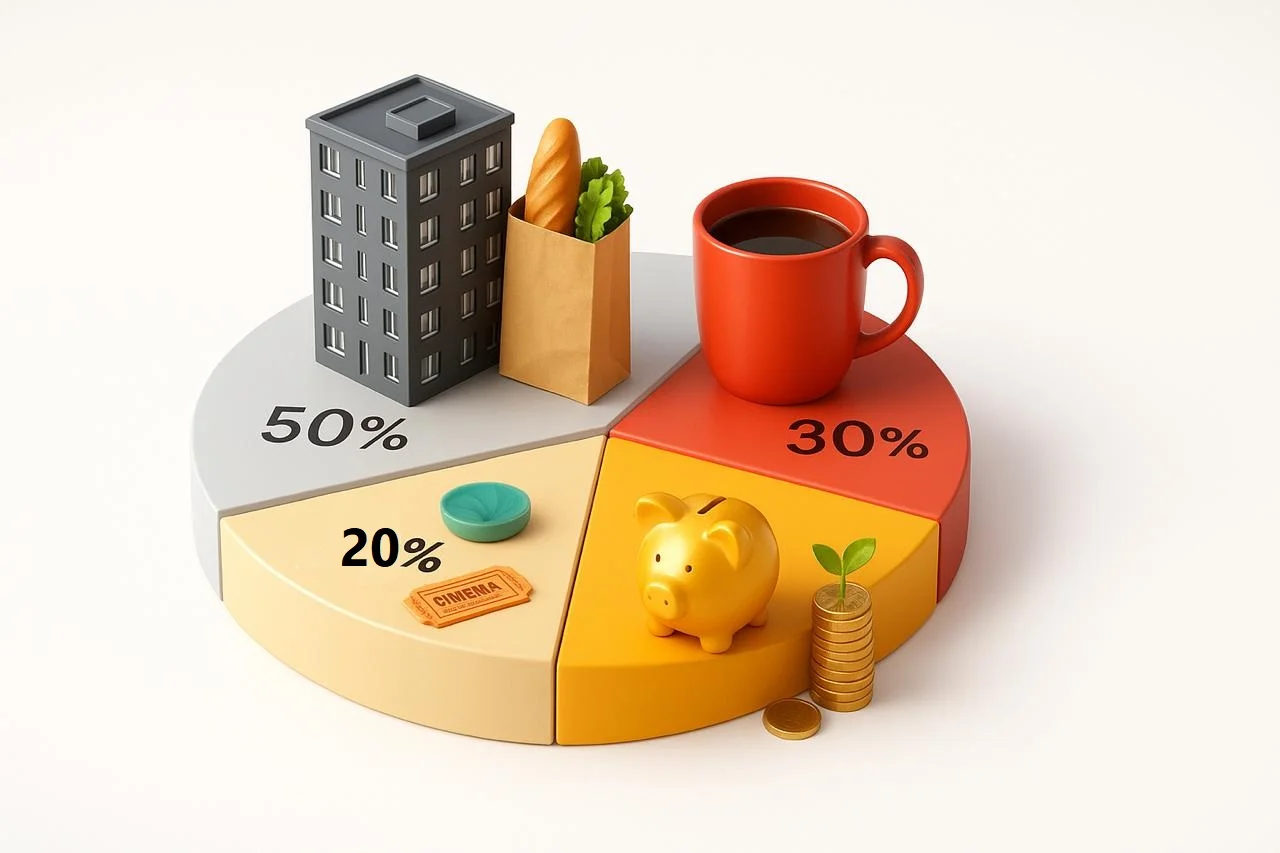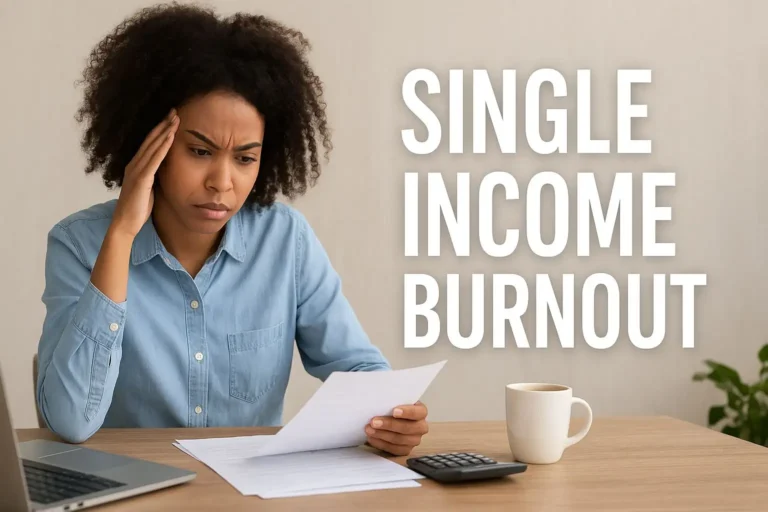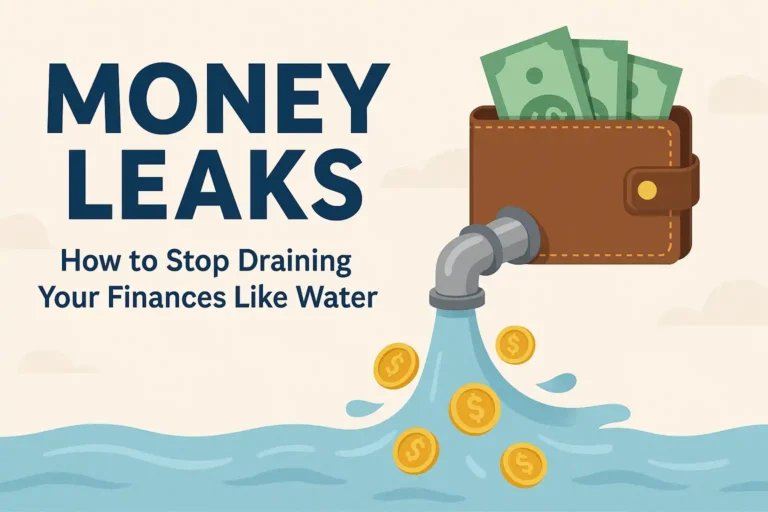Originally Published: February 2025 | Last Updated: October 2025
Ever feel like your money is playing hide-and-seek… and it is really good at hiding?
Let’s be honest—budgeting has a terrible PR problem.
The word itself sounds boring, restrictive, and about as fun as eating plain oatmeal for dinner. Most people imagine spreadsheets, calculators, and endless hours trying to figure out where their money went (spoiler alert: usually on Amazon, Uber Eats, and “just one more” subscription).
But here is the truth: budgeting is not about restriction—it is about freedom.
Think about it like this: if your money was a group of hyperactive kids at a birthday party, a budget is the adult in the room making sure nobody jumps into the cake. Without it, chaos reigns. With it, everyone has fun, and the cake survives.
And the best part? You don’t have to create a complicated system. That’s why I’ve made a free budgeting template in Excel—so you can stop stressing and start planning in less than 10 minutes.
By the end of this post, you’ll know:
• Why budgeting is the #1 habit that separates financial stress from financial freedom.
• How to use a free Excel budgeting template even if you’ve never touched a spreadsheet.
• Simple strategies to save money, pay off debt, and reach goals faster.
• The secret mindset shift that makes sticking to a budget easy.
1️⃣ What Exactly is a Budget (and Why Most People Get it Wrong)?
A budget is simply a plan for your money. That is it. It is not a prison. It’s not a punishment. It is a roadmap telling your dollars where to go instead of wondering where they went.
Here’s the biggest misconception: people think budgeting is only for broke people trying to stretch every penny. Wrong. Even millionaires use budgets (just with bigger numbers).
Imagine going on a road trip without GPS. You would waste gas, time, and probably end up lost. A budget is that GPS—it guides you toward your financial goals.
Takeaway: A budget is your money’s personal trainer. It gets your finances in shape so you can reach your goals.
# Action Step:
• Get the Free Budgeting Template (as per your age, lifestyle, earning etc.).
• Write down your total monthly income.
• List your must-pay expenses (rent, bills, groceries).
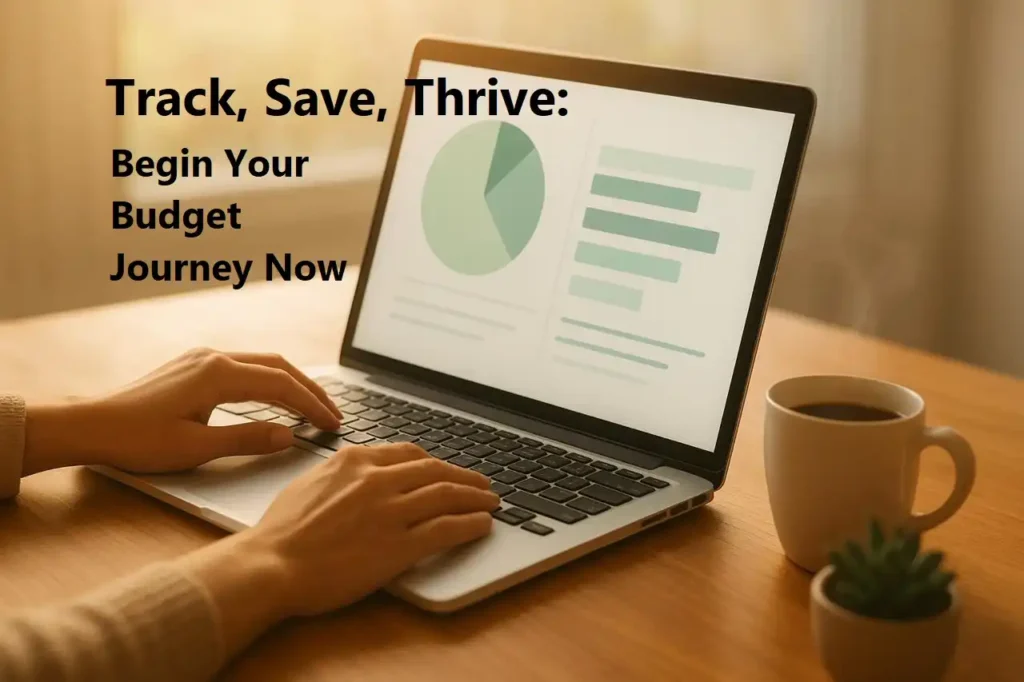
2️⃣ Why Beginners Struggle With Budgeting (and How to Fix It)
Let’s play a quick game:
👉 Do you start the month with a plan, only to give up halfway?
👉 Do you tell yourself “I will save what is left over” but nothing is left?
👉 Do you feel guilty every time you buy something fun?
If you said yes to any of these, you are not bad at budgeting—you just don’t have a system that works for you.
The good news? This free budgeting template does the heavy lifting. Instead of writing numbers on scraps of paper or using apps that confuse you with too many graphs, you will have one clear sheet that tracks income, expenses, and savings.
Takeaway: You don’t fail at budgeting because you’re bad with money—you fail because you don’t have the right tool.
# Action Step:
• Commit to using the template for just one month.
• Do not aim for perfection—just start tracking where money goes.
3️⃣ The Latte Factor: Why Small Expenses Sink Your Budget
Here is the story of Mark. Every day, Mark grabbed a $6 coffee on the way to work. No big deal, right? Except over a month, that’s $180. Over a year, it’s $2,160. That is enough to pay off a credit card or go on a vacation!
This is called the Latte Factor—those small daily expenses that sneak into your budget like ninjas.
But here is the kicker: you don’t have to give up everything you love. Budgeting is not about cutting all joy—it’s about choosing. Maybe Mark keeps his Friday latte as a treat but brews coffee at home the rest of the week. That small tweak saves him $1,500 a year.
Takeaway: Small leaks sink big ships. Plug the little expenses, and you will see big savings.
# Action Step:
• Use the budgeting template to track every small expense for 7 days.
• Circle one that does not add much joy. Cut it—or reduce it.
4️⃣ SMART Goals: Turning “Save More” Into “Save $1,000”
Most people fail at budgeting because their goals are vague.
“Save more money” sounds nice but doesn’t move the needle.
Instead, set SMART goals (Specific, Measurable, Achievable, Relevant, Time-bound).
Example: “I will save $1,000 in emergency fund in 6 months by setting aside $167 per month.”
Now you have got clarity. The budgeting template helps by showing exactly how much you need to save each month.
Takeaway: Clear goals = clear motivation.
# Action Step:
• Write down 2-3 SMART goals in the template.
• Break them into monthly savings targets.
5️⃣ Pay Yourself First: The #1 Rule of Successful Budgeters
Here is a mindset shift: savings are not “extra money.” They are bills you owe your future self.
That is why successful budgeters pay themselves first. Instead of saving “what is left,” they save before spending on extras.
Think of it like brushing your teeth—you do not skip it because you had a busy day. Saving is non-negotiable.
Takeaway: Treat savings like rent—it gets paid no matter what.
# Action Step:
• Set up an automatic transfer on payday.
• Put savings in a separate account so you are not tempted to spend it.
6️⃣ Emergency Funds: Because Life Happens
Flat tires. Medical bills. Lost jobs. Life is unpredictable, and that’s why every beginner needs an emergency fund.
Aim for at least $1,000 to start, then grow it to 3–6 months of expenses. This one account can stop a bad day from becoming a financial disaster.
Takeaway: Your emergency fund is financial armor.
# Action Step:
• Open a separate account just for emergencies.
• Start small—even $20/week builds momentum.
7️⃣ Zero-Based Budgeting: Giving Every Dollar a Job
Ever wonder why money slips through your fingers? It is because it does not have a job.
Zero-based budgeting solves that. Every dollar you earn gets assigned—whether to bills, savings, or fun. At the end, your income minus expenses equals zero (not because you are broke, but because every dollar is working for you).
The free budgeting template is designed with this in mind—making sure nothing gets wasted.
Takeaway: Idle money is wasted money. Give every dollar a mission.
# Action Step:
• Fill out the template so income = expenses + savings.
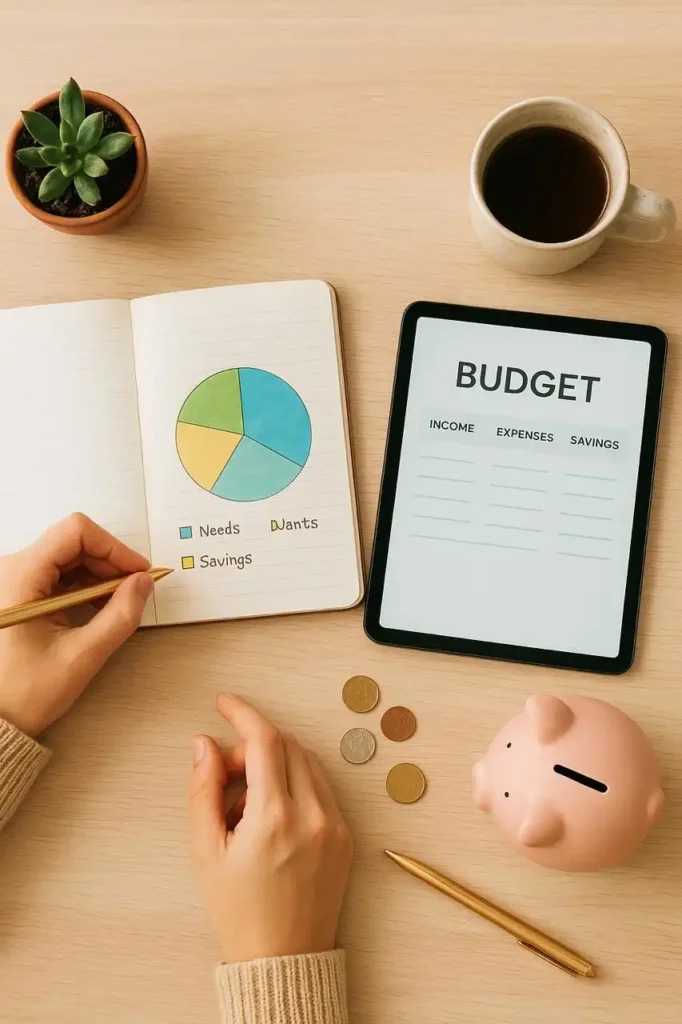
8️⃣ Mastering the 50/30/20 Rule
The 50/30/20 budgeting rule is one of the simplest and most effective frameworks to organize your personal finances. It divides your income into three clear categories—50% for needs, 30% for wants, and 20% for savings or debt repayment. By using a free budgeting template, you can easily apply this rule without getting lost in complicated formulas.
This method works especially well for beginners because it transforms overwhelming money management into an approachable system. After all it is Your Money and Your Rules. The 50/30/20 rule ensures that your essentials are covered, your lifestyle expenses are guilt-free, and your savings steadily grow.
# Action Step: Apply the 50/30/20 Rule to Your Finances
- Get a free budgeting template (Excel or Google Sheets – Comment below).
- Input your monthly income in the tracker.
- Allocate 50% of your income to essentials like rent, groceries, and utilities.
- Assign 30% for discretionary wants such as dining, entertainment, or travel.
- Dedicate 20% to savings, investments, or debt repayment using a monthly expense tracker template.
By consistently tracking expenses with this rule, you’ll stay financially balanced and build long-term wealth without the stress of micromanaging every dollar.
Bonus Tips to Get the Most Out of a Budgeting Template
A Free Budgeting Template is not just a spreadsheet — it’s like a GPS for your money. But just like a GPS won’t help if you ignore it, a budgeting template only works when you actively use it. Here are some killer bonus tips to maximize results:
1. Customize It to Fit Your Life
Many people download a free budget planner Excel file and expect miracles. But one size rarely fits all. Personalize the categories. For example, if you love weekend road trips, add a “Travel” column. If fitness is your priority, create a “Health & Wellness” bucket. By making the monthly expense tracker template reflect your real life, you’ll actually stick to it.
Action Step: After downloading a budget template for beginners, spend 20 minutes tailoring categories to your lifestyle.
2. Automate the Data Wherever Possible
Manual entry is the reason most people give up. Link your bank account to apps (or use formulas in Excel) to auto-import transactions into your downloadable budgeting spreadsheet. This cuts the boring work and helps you focus on insights.
Pro Tip: If you don’t want to connect accounts, schedule a 10-minute weekly “money date” where you quickly copy expenses from your bank statement into your personal finance budgeting sheet.
3. Use Visuals to Stay Motivated
Numbers can feel cold, but visuals inspire action. Add pie charts or bar graphs into your budget worksheet Excel free download to see where your money goes. Watching “eating out” shrink while “savings” grows is more motivating than staring at numbers.
Action Step: In your financial planning Excel template, insert a savings progress bar — it creates a sense of achievement each month.
4. Start Small: One Month at a Time
Most people quit budgeting because they try to predict an entire year. Instead, focus on 30 days. Use an easy monthly budget plan to review your income, needs, and wants for just one month. Once you’ve nailed that, expand to quarterly or yearly reviews.
5. Separate Needs, Wants, and Goals
A simple household budget template works best when you clearly separate essential expenses (needs), lifestyle spending (wants), and future-building (savings/debt payoff). This mirrors the classic 50/30/20 approach but lets you adapt based on your own situation.
6. Make Savings Automatic
A free savings and budget calculator is great, but don’t stop at planning. Set up automatic transfers to savings accounts right after payday. This ensures the “savings” category in your expense tracker spreadsheet free does not get swallowed by impulse purchases.
7. Track Progress, Not Perfection
Budgeting isn’t about punishing yourself — it’s about progress. Maybe you overspend on dining out but save more than expected elsewhere. That’s still a win. Over time, your monthly expense tracker template will show trends that help you improve.
Takeaway: A Free Budgeting Template is not just a document — it’s a living system. Customize it, automate it, and review it regularly. Over time, you will transform budgeting from a dreaded chore into a life-changing habit.
Frequently Asked Questions (FAQs)
1. What is a Free Budgeting Template?
A Free Budgeting Template is a ready-made spreadsheet (often in Excel or Google Sheets) designed to help you track income, expenses, and savings. Think of it as your personal money dashboard. Instead of scribbling numbers on random papers, everything lives in one organized sheet.
2. How do I start budgeting with Excel if I’m a beginner?
It’s simpler than it sounds. Get a budgeting template for beginners, open it in Excel, and start by adding your monthly income. Then list fixed expenses (rent, utilities, groceries), followed by variable ones (entertainment, dining out). The template does the math for you.
If you’re overwhelmed, begin with just three categories: Income, Needs, Savings. Expand as you get comfortable.
3. Is it better to use a free budget planner Excel file or apps?
Both work. A downloadable budgeting spreadsheet gives you full control and privacy. Apps are more automated but may charge fees. Many people start with a budget worksheet Excel free download to build discipline, then move to apps once they want automation.
4. Can a Free Budgeting Template help me save money?
Absolutely. By seeing exactly where your money goes, you’ll spot leaks — maybe $200 on unused subscriptions or $150 in coffee runs. Once you catch these, you can redirect that money into savings. A free money management template is like holding a mirror to your spending habits.
5. How is a budget template different from an expense tracker?
Good question. An expense tracker spreadsheet free records where your money went after spending, while a monthly expense tracker template + budget actually plans where your money should go ahead of time. Use both: one for planning, one for accountability.
6. What’s the best way to track income and expenses?
For beginners, the best way to track income and expenses is with a simple Excel or Google Sheet. A personal finance budgeting sheet lets you categorize every dollar into needs, wants, or savings. Over time, this builds awareness and control.
7. Can I use a budgeting template for irregular income?
Yes! If your income varies (freelancers, gig workers, entrepreneurs), use averages. Base your easy monthly budget plan on your lowest consistent income. Extra money can go directly to savings or debt payoff.
8. What if I’m not good at math?
That’s the beauty of a budget worksheet Excel free download — it does the math for you. With built-in formulas, you just enter numbers and watch the totals update instantly.
9. How does a Free Budgeting Template fit into long-term financial planning?
It’s the foundation. A financial planning Excel template helps you build short-term control, which then fuels long-term goals like paying off debt, saving for a home, or retiring early. You can’t build wealth without first mastering daily money habits.
10. Is the 50/30/20 budget rule realistic for everyone?
Yes and no. The 50/30/20 budget rule is a flexible framework, but your financial situation matters. If you’re living paycheck to paycheck or in a high-cost area, hitting these exact ratios may be tough. The key is to use it as a guideline and adjust percentages while maintaining savings as a priority.
11. What if I can’t save 20% of my income?
Do not give up. Saving even 5–10% is better than nothing. Over time, aim to increase this percentage as your income grows or expenses decrease. Think of the rule as a financial muscle—you build strength gradually.
12. How do I decide what counts as a “need” versus a “want”?
A need is essential for survival and stability—rent, utilities, groceries, insurance. A want adds comfort or enjoyment—Netflix, dining out, vacations. When in doubt, ask: “Can I live without this?” If the answer is yes, it’s a want.
13. Can I use the 50/30/20 budget rule for irregular income?
Absolutely. Freelancers, entrepreneurs, and gig workers can still benefit. The trick is to base percentages on your average monthly income. In months you earn extra, funnel more into savings to balance lower-income months.
14. How does the rule compare to other budgeting methods?
The 50/30/20 budget rule is considered a simple budgeting method ideal for beginners. Other strategies, like zero-based budgeting, are more detailed but harder to maintain. The advantage here is simplicity—making it easy to stick with long-term.
15. Should I include debt payments in “needs” or “savings”?
Minimum debt payments belong in needs (since they’re mandatory), but extra payments above the minimum go in the 20% savings/debt category. This ensures you’re reducing debt aggressively while still covering essentials.
16. Can the rule help me retire early?
Yes. If you boost the savings portion beyond 20%—say to 30–40%—you accelerate wealth building. Many financial independence followers use a modified version of the rule to fast-track early retirement goals.
17. Is the 50/30/20 rule outdated in 2025?
Not at all. While costs of living have risen, the principle of balancing needs, wants, and savings remains timeless. It’s adaptable, simple, and beginner-friendly, which keeps it relevant even in changing economies.
Takeaway: A Free Budgeting Template simplifies budgeting for beginners step by step. Whether you want to cut expenses, build savings, or just feel in control, it’s one of the most powerful tools you can get — and it is free.

Common Mistakes
- Not Updating Regularly – Entering numbers once a month isn’t enough. Use your monthly expense tracker template at least weekly.
- Overcomplicating Categories – Beginners often add too many columns. Start simple: Income, Needs, Wants, Savings.
- Forgetting Irregular Expenses – Car insurance, holidays, or annual subscriptions often get ignored. Add a “Sinking Fund” category in your personal finance budgeting sheet.
- Being Too Rigid – Life happens. If you overspend in one category, adjust next month instead of giving up.
- Not Reviewing Progress – A budgeting template for beginners only works if you reflect. Monthly reviews turn data into decisions.
Exercise Time
Grab your Free Budgeting Template (Excel, Google Sheets, or any version you like) and try this 15-minute exercise:
1. Write down your income. Add all sources — salary, side gigs, bonuses.
2. List three biggest expenses. Highlight the top three areas where money flows out.
3. Assign percentages. Compare your spending with the 50/30/20 rule (50% needs, 30% wants, 20% savings).
4. Spot one change. Maybe cut $50 from dining out or pause a subscription.
5. Reallocate to savings. Move that money into the “20% savings” section in your free savings and budget calculator.
Now ask yourself: “If I repeat this every month for the next year, how much closer would I be to my financial goals?”
This reflection turns your free budgeting template from a static sheet into a powerful tool for transformation.
Conclusion: Small Steps, Big Results
Budgeting isn’t about becoming a money robot. It’s about clarity, peace of mind, and the freedom to spend on what actually matters.
Imagine:
• No more guilt over every purchase.
• No more wondering where your paycheck went.
• No more sleepless nights over bills.
It all starts with one small step: get your budgeting template and filling it out today.
Call to Action (CTA):
🎉 Ready to start your journey?
Comment below to get Your FREE Budgeting Template Now!
Share your biggest budgeting struggle in the comments—I’d love to help!
Subscribe for weekly tips that make money simple and stress-free.
Share this with a friend who needs a financial reset!
Stop Guessing. Start Growing with Smarter Geoarbitrage: How to Live Rich by Earning in Dollars and Spending in Pesos

